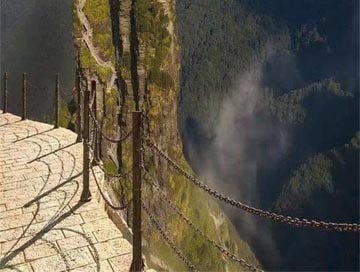Ep. 110: Marketing Maitreya at Buddhism's "Fifth Mountain"
Don't believe everything you see--or read
We interrupt our tour of Hangzhou's Lingyin Temple for this very special episode of Temple Tales!
A friend recently sent me a photo. It showed two tiny buildings perched atop a huge spire of rock. Behind is a conical, snowcapped mountain with an inverted bowl of cloud over it. My friend asked, "What are the chances this is a 'real' photo?"
My verdict: The temple is real; the mountain is Japan's Fuji PhotoShopped into the background. I don't usually use other people's photos in this newsletter--I have enough of my own--but I have taken the liberty of sharing the photo here, for educational purposes only. The original can be seen here.





